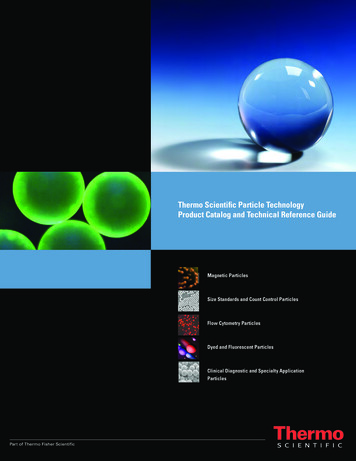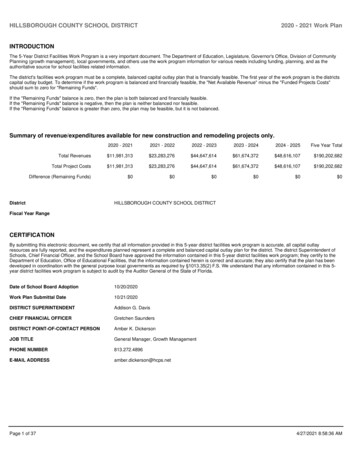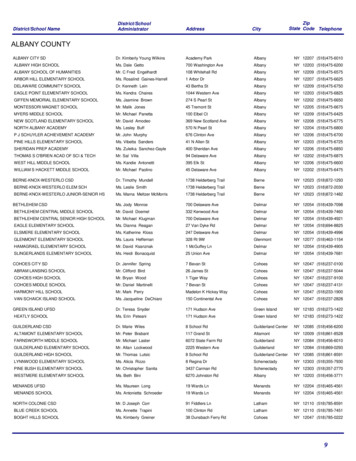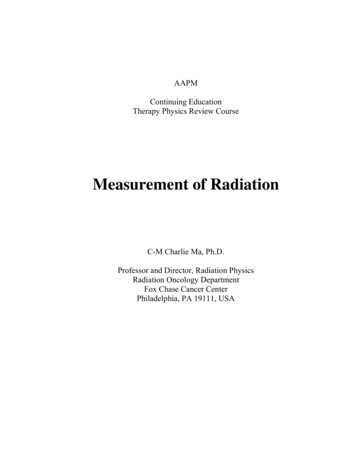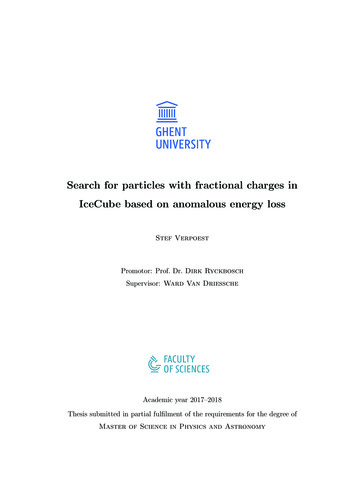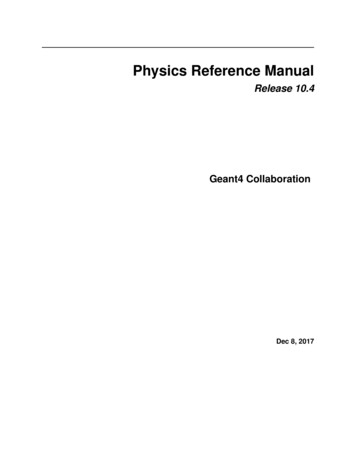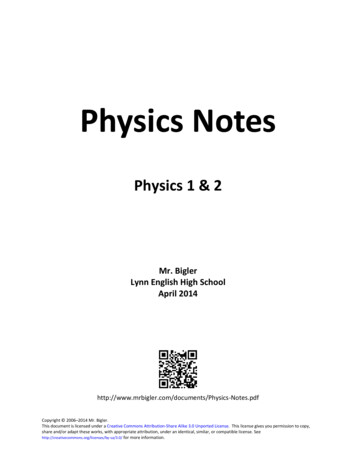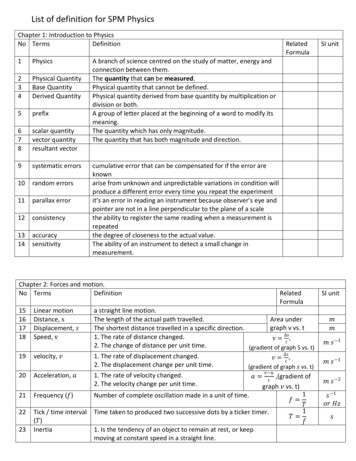
Transcription
ELEMENTARY PARTICLES IN PHYSICS1Elementary Particles in PhysicsS. Gasiorowicz and P. LangackerElementary-particle physics deals with the fundamental constituents of matter and their interactions. In the past several decades an enormous amount ofexperimental information has been accumulated, and many patterns and systematic features have been observed. Highly successful mathematical theoriesof the electromagnetic, weak, and strong interactions have been devised andtested. These theories, which are collectively known as the standard model, arealmost certainly the correct description of Nature, to first approximation, downto a distance scale 1/1000th the size of the atomic nucleus. There are also speculative but encouraging developments in the attempt to unify these interactionsinto a simple underlying framework, and even to incorporate quantum gravityin a parameter-free “theory of everything.” In this article we shall attempt tohighlight the ways in which information has been organized, and to sketch theoutlines of the standard model and its possible extensions.Classification of ParticlesThe particles that have been identified in high-energy experiments fall into distinct classes. There are the leptons (see Electron, Leptons, Neutrino, Muonium),all of which have spin 21 . They may be charged or neutral. The charged leptons have electromagnetic as well as weak interactions; the neutral ones onlyinteract weakly. There are three well-defined lepton pairs, the electron (e ) andthe electron neutrino (νe ), the muon (µ ) and the muon neutrino (νµ ), and the(much heavier) charged lepton, the tau (τ ), and its tau neutrino (ντ ). Theseparticles all have antiparticles, in accordance with the predictions of relativisticquantum mechanics (see CPT Theorem). There appear to exist approximate“lepton-type” conservation laws: the number of e plus the number of νe minus the number of the corresponding antiparticles e and ν̄e is conserved inweak reactions, and similarly for the muon and tau-type leptons. These conservation laws would follow automatically in the standard model if the neutrinosare massless. Recently, however, evidence for tiny nonzero neutrino masses andsubtle violation of these conservations laws has been observed. There is no understanding of the hierarchy of masses in Table 1 or why the observed neutrinosare so light.In addition to the leptons there exist hadrons (see Hadrons, Baryons, Hyperons, Mesons, Nucleon), which have strong interactions as well as the electromagnetic and weak. These particles have a variety of spins, both integraland half-integral, and their masses range from the value of 135 MeV/c2 for theneutral pion π 0 to 11 020 MeV/c2 for one of the upsilon (heavy quark) states.The particles with half-integral spin are called baryons, and there is clear evidence for baryon conservation: The number of baryons minus the number ofantibaryons is constant in any interaction. The best evidence for this is thestability of the lightest baryon, the proton (if the proton decays, it does so witha lifetime in excess of 1033 yr). In contrast to charge conservation, there is no
2Table 1: The leptons. Charges are in units of the positron (e ) charge e 1.602 10 19 coulomb. In addition to the upper limits, two of the neutrinoshave masses larger than 0.05 eV/c2 and 0.005 eV/c2 , respectively. The νe , νµ ,and ντ are mixtures of the states of definite mass.ParticleQ Masse 1 0.51 MeV/c2µ 1 105.7 MeV/c2 τ 1 1777 MeV/c2νe0 0.15 eV/c2νµ0 0.15 eV/c2ντ0 0.15 eV/c2Table 2: The quarks (spin- 12 constituents of hadrons). Each quark carries baryonnumber B 31 , while the antiquarks have B 31 .ParticleQ Massu (up)d (down)s (strange)c (charm)b (bottom)t (top)23 31 3123 31231.5 5 MeV/c25 9 MeV/c280 155 MeV/c21 1.4 GeV/c24 4.5 GeV/c2175 180 GeV/c2deep principle that makes baryon conservation compelling, and it may turn outthat baryon conservation is only approximate. The particles with integer spinare called mesons, and they have baryon number B 0. There are hundreds ofdifferent kinds of hadrons, some almost stable and some (known as resonances)extremely short-lived. The degree of stability depends mainly on the mass ofthe hadron. If its mass lies above the threshold for an allowed decay channel,it will decay rapidly; if it does not, the decay will proceed through a channelthat may have a strongly suppressed rate, e. g., because it can only be drivenby the weak or electromagnetic interactions. The large number of hadrons hasled to the universal acceptance of the notion that the hadrons, in contrast tothe leptons, are composite. In particular, experiments involving lepton–hadronscattering or e e annihilation into hadrons have established that hadrons arebound states of point-like spin- 21 particles of fractional charge, known as quarks.Six types of quarks have been identified (Table 2). As with the leptons, thereis no understanding of the extreme hierarchy of quark masses. For each typeof quark there is a corresponding antiquark. Baryons are bound states of threequarks (e. g., proton uud; neutron udd), while mesons consist of a quarkand an antiquark. Matter and decay processes under normal terrestrial conditions involve only the e , νe , u, and d. However, from Tables 2 and 3 we
ELEMENTARY PARTICLES IN PHYSICS3see that these four types of fundamental particle are replicated in two heavierfamilies, (µ , νµ , c, s) and (τ , ντ , t, b). The reason for the existence of theseheavier copies is still unclear.Classification of InteractionsFor reasons that are still unclear, the interactions fall into four types, the electromagnetic, weak, and strong, and the gravitational interaction. If we take theproton mass as a standard, the last is 10 36 times the strength of the electromagnetic interaction, and will mainly be neglected in what follows. (The unificationof gravity with the other interactions is one of the major outstanding goals.)The first two interactions were most cleanly explored with the leptons, which donot have strong interactions that mask them. We shall therefore discuss themfirst in terms of the leptons.Electromagnetic InteractionsThe electromagnetic interactions of charged leptons (electron, muon, and tau)are best described in terms of equations of motion, derived from a Lagrangianfunction, which are solved in a power series in the fine-structure constant e2 /4π c α 1/137, a small parameter. The Lagrangian density consists of a term thatdescribes the free-photon field,1Lγ Fµν (x)F µν (x) ,4(1)where Aν (x) Aµ (x) (2) xµ xνis the electromagnetic field tensor. Lγ is just 21 [E2 (x) B2 (x)] in more commonnotation. It is written in terms of the vector potential Aµ (x) because the termsthat involve the lepton and its interaction with the electromagnetic field aresimplest when written in terms of Aµ (x): Ll iψ̄(x)γ α ieA(x)ψ(x) mψ̄(x)ψ(x) .(3)α xαFµν (x) Here ψ(x) is a four-component spinor representing the electron, muon, or tau,ψ̄(x) ψ † (x)γ 0 , the γ α (α 0, 1, 2, 3) are the Dirac matrices [4 4 matricesthat satisfy the conditions (γ 1 )2 (γ 2 )2 (γ 3 )2 (γ 0 )2 1 and γ α γ β γ β γ α for β 6 α]; m has the dimensions of a mass in the natural units in which c 1. If e were zero, the Lagrangian would describe a free lepton; withe 6 0 the interaction has the form eAα (x)jα (x) ,(4)where the current jα (x) is given byjα (x) ψ̄(x)γα ψ(x) .(5)
4The equations of motion show that the current is conserved, jα (x) 0 , xαso that the chargeQ Zd3 r j0 (r, t)(6)(7)is a constant of the motion.The form of the interaction is obtained by making the replacement ieAα (x) xα xα(8)in the Lagrangian for a free lepton. This minimal coupling follows from a deepprinciple, local gauge invariance. The requirement that ψ(x) can have its phasechanged locally without affecting the physics of the lepton, that is, invarianceunderψ(x) e iθ(x) ψ(x) ,(9)can only be implemented through the introduction of a vector field Aα (x), coupled as in (8), and transforming according toAα (x) Aα (x) 1 θ(x).e xα(10)This dictates that the free-photon Lagrangian density contains only the gaugeinvariant combination (2), and that terms of the form M 2 A2α (x) be absent. Thuslocal gauge invariance is a very powerful requirement; it implies the existenceof a massless vector particle (the photon, γ), which mediates a long-range force[Fig. 1(a)]. It also fixes the form of the coupling and leads to charge conservation,and implies masslessness of the photon. The resulting theory (see QuantumElectrodynamics, Compton Effect, Feynman Diagrams, Muonium, Positron) isin extremely good agreement with experiment, as Table 3 shows. In workingout the consequences of the equations of motion that follow from (3), infinitiesappear, and the theory seems not to make sense. The work of S. Tomonaga,J. Schwinger, R. P. Feynman, and F. J. Dyson in the late 1940s clarified thenature of the problem and showed a way of eliminating the difficulties. Increating renormalization theory these authors pointed out that the parameterse and m that appear in (3) can be identified as the charge and the mass ofthe lepton only in lowest order. When the charge and mass are calculated inhigher order, infinite integrals appear. After a rescaling of the lepton fields,it turns out that these are the only infinite integrals in the theory. Thus byabsorbing them into the definitions of new quantities, the renormalized (i. e.,physically measured) charge and mass, all infinities are removed, and the restof the theoretically calculated quantities are finite. Gauge invariance ensuresthat in the renormalized theory the current is still conserved, and the photonremains massless (the experimental upper limit on the photon mass is 6 10 17eV/c2 ).
5ELEMENTARY PARTICLES IN PHYSICSFig. 1: (a) Long-range force between electron and proton mediated by a photon.(b) Four-fermi (zero-range) description of beta decay (n pe ν̄e ). (c) Betadecay mediated by a W . (d) A neutral current process mediated by the Z.Table 3: Extraction of the (inverse) fine structure constant α 1 from variousexperiments, adapted from T. Kinoshita, J. Phys. G 29, 9 (2003). The consistency of the various determinations tests QED. The numbers in parentheses(square brackets) represent the uncertainty in the last digits (the fractionaluncertainty). The last column is the difference from the (most precise) valueα 1 (ae ) in the first row. A precise measurement of the muon gyromagneticratio aµ is 2.4σ above the theoretical prediction, but that quantity is moresensitive to new (TeV-scale) physics.ExperimentDeviation from gyromagneticratio, ae (g 2)/2 for e ac Josephson effecth/mn (mn is the neutron mass)from n beamHyperfine structure inmuonium, µ e Cesium D1 lineValue of α 1137.035 999 58 (52)[3.8 10 9 ]Difference from α 1 (ae )–137.035 988 0 (51)137.036 011 9 (51)[3.7 10 8 ][3.7 10 8 ](0.116 0.051) 10 4( 0.123 0.051) 10 4137.035 993 2 (83)[6.0 10 8 ](0.064 0.083) 10 4137.035 992 4 (41)[3.0 10 8 ](0.072 0.041) 10 4
6Subsequent work showed that the possibility of absorbing the divergences ofa theory in a finite number of renormalizations of physical quantities is limited to a small class of theories, e. g., those involving the coupling of spin- 21to spin-0 particles with a very restrictive form of the coupling. Theories involving vector (spin-1) fields are only renormalizable when the couplings areminimal and local gauge invariance holds. Thus gauge-invariant couplings likeψ̄(x)γ α γ β ψ(x)Fαβ (x), which are known not to be needed in quantum electrodynamics, are eliminated by the requirement of renormalizability. (The apparentinfinities for non-renormalizable theories become finite when the theories areviewed as a low energy approximation to a more fundamental theory. In thatcase, however, the low energy predictions have a very large sensitivity to theenergy scale at which the new physics appears.)The electrodynamics of hadrons involves a coupling of the form eAα (x)jαhad (x) .(11)For one-photon processes, such as photoproduction (e. g., γp π 0 p), matrixelements of the conserved current jαhad (x) are measured to first order in e, whilefor two-photon processes, such as hadronic Compton scattering (γp γp),matrix elements of products like jαhad (x)jβhad (y) enter. Within the quark theoryone can write an explicit form for the hadronic current:jαhad (x) 11 α2 αd s̄γ α s . . . ,ūγ u dγ333(12)where we use particle labels for the spinor operators (which are evaluated at x),and the coefficients are just the charges in units of e. The total electromagneticinteraction is therefore eAα jαγ , whereX(13)Qi ψ̄i γα ψi ,jαγ jα jαhad iand the sum extends over all the leptons and quarks (ψi e, µ, τ , νe , νµ , ντ ,u, d, c, s, b, t), and where Qi is the charge of ψi .Weak InteractionsIn contrast to the electromagnetic interaction, whose form was already contained in classical electrodynamics, it took many decades of experimental andtheoretical work to arrive at a compact phenomenological Lagrangian densitydescribing the weak interactions. The formGLW Jα† (x)J α (x)2(14)involves vectorial quantities, as originally proposed by E. Fermi. The currentJ α (x) is known as a charged current since it changes (lowers) the electric chargewhen it acts on a state. That is, it describes a transition such as νe e of one
ELEMENTARY PARTICLES IN PHYSICS7particle into another, or the corresponding creation of an e ν̄e pair. Similarly,Jα† describes a charge-raising transition such as n p. Equation (14) describesa zero-range four-fermi interaction [Fig. 1(b)], in contrast to electrodynamics, inwhich the force is transmitted by the exchange of a photon. An additional classof “neutral-current” terms was discovered in 1973 (see Weak Neutral Currents,Currents in Particle Theory). These will be discussed in the next section. J α (x)consists of leptonic and hadronic parts:ααJ α (x) Jlept(x) Jhad(x) .(15)Thus, it describes purely leptonic interactions, such asµ νµ e e ν̄e νµ , νe µ ,through terms quadratic in Jlept ; semileptonic interactions, most exhaustivelystudied in decay processes such asnπ Λ0 p e ν̄e (beta decay) , µ νµ , p e ν̄e ,and more recently in neutrino-scattering reactions such asνµ nν̄µ p µ p (or µ hadrons) , µ n (or µ hadrons) ;αand, through terms quadratic in Jhad, purely nonleptonic interactions, such asΛ0K p π , π π π ,in which only hadrons appear. The coupling is weak in that the natural dimensionless coupling, with the proton mass as standard, is Gm2p 1.01 10 5,where G is the Fermi constant.The leptonic current consists of the termsαJlept(x) ēγ α (1 γ5 )νe µ̄γ α (1 γ5 )νµ τ̄ γ α (1 γ5 )ντ .(16)Both polar and axial vector terms appear (γ5 iγ 0 γ 1 γ 2 γ 3 is a pseudoscalarmatrix), so that in the quadratic form (14) there will be vector–axial-vectorinterference terms, indicating parity nonconservation. The discovery of thisphenomenon, following the suggestion of T. D. Lee and C. N. Yang in 1956 thatreflection invariance in the weak interactions could not be taken for granted buthad to be tested, played an important role in the determination of the phenomenological Lagrangian (14). The experiments suggested by Lee and Yangall involved looking for a pseudoscalar observable in a weak interaction experiment (see Parity), and the first of many experiments (C. S. Wu, E. Ambler, R.
8W. Hayward, D. D. Hoppes, and R. F. Hudson) measuring the beta decay ofpolarized nuclei (60 Co) showed an angular distribution of the formW (θ) A Bpe · hJi ,(17)where pe is the electron momentum and hJi the polarization of the nucleus. Thedistribution W (θ) is not invariant under mirror inversion (P ) which changesJ J and pe pe , so the experimental form (17) directly showed paritynonconservation. Experiments showed that both the hadronic and the leptoniccurrents had vector and axial-vector parts, and that although invariance underparticle–antiparticle (charge) conjugation C is also violated, the form (14) maintains invariance under the joint symmetry CP (see Conservation Laws) whenrestricted to the light hadrons (those consisting of u, d, c, and s). There is evidence that CP itself is violated at a much weaker level, of the order of 10 5 ofthe weak interactions. As will be discussed later, this is consistent with secondorder weak effects involving the heavy (b, t) quarks, though it is possible thatan otherwise undetected superweak interaction also plays a role. The part ofαJhadrelevant to beta decay is ūγα (1 γ5 )d. The detailed form of the hadroniccurrent will be discussed after the description of the strong interactions.Even at the leptonic level the theory described by (14) is not renormalizable.This manifests itself in the result that the cross section for neutrino absorptiongrows with energy:σν (const)G2 mp Eν .(18)While this behavior is in accord with observations up to the highest energiesstudied so far, it signals a breakdown of the theory at higher energies, so that(14) cannot be fundamental. A number of people suggested over the years thatthe effective Lagrangian is but a phenomenological description of a theory inwhich the weak current J α (x) is coupled to a charged intermediate vector bosonWα (x), in analogy with quantum electrodynamics. The form (14) emerges fromthe exchange of a vector meson between the currents (see Feynman Diagrams)when the W mass is much larger than the momentum transfer in the process[Fig. 1(c)]. The intermediate vector boson theory leads to a better behaved σνat high energies. However, massive vector theories are still not renormalizable,and the cross section for e e W W (with longitudinally polarized W s)grows with energy. Until 1967 there was no theory of the weak interactionsin which higher-order corrections, though extraordinarily small because of theweak coupling, could be calculated.Unified Theories of the Weak and Electromagnetic InteractionsIn spite of the large differences between the electromagnetic and weak interactions (massless photon versus massive W , strength of coupling, behavior underP and C ), the vectorial form of the interaction hints at a possible commonorigin. The renormalization barrier seems insurmountable: A theory involving
ELEMENTARY PARTICLES IN PHYSICS9vector bosons is only renormalizable if it is a gauge theory; a theory in which acharged weak current of the form (16) couples to massive charged vector bosons,LW gW [J α† (x)Wα (x) J α (x)Wα (x)] ,(19)does not have that property. Interestingly, a gauge theory involving chargedvector mesons, or more generally, vector mesons carrying some internal quantumnumbers, had been invented by C. N. Yang and R. L. Mills in 1954. Theseauthors sought to answer the question: Is it possible to construct a theory thatis invariant under the transformationψ(x) exp[iT · θ(x)]ψ(x) ,(20)where ψ(x) is a column vector of fermion fields related by symmetry, the Ti arematrix representations of a Lie algebra (see Lie Groups, Gauge Theories), andthe θ(x) are a set of angles that depend on space and time, generalizing thetransformation law (9)? It turns out to be possible to construct such a nonAbelian gauge theory. The coupling of the spin- 21 field follows the “minimal”form (8) in that iψ̄γ α α ψ ψ̄γ α igTW(x)ψ,(21)i α x xαwhere the Wi are vector (gauge) bosons, and the gauge coupling constant g is ameasure of the strength of the interaction. The vector meson form is again1LV Fµνi (x)Fiµν (x) ,4(22)but now the structure of the fields is more complicated than in (2):Fµνi (x) W i (x) ν Wµi (x) gfijk Wµj (x)Wνk (x) , xµ ν x(23)because the vector fields Wµi themselves carry the “charges” (denoted by thelabel i); thus, they interact with each other (unlike electrodynamics), and theirtransformation law is more complicated than (10). The numbers fijk that appear in the additional nonlinear term in (23) are the structure constants of thegroup under consideration, defined by the commutation rules[Ti , Tj ] ifijk Tk .(24)There are as many vector bosons as there are generators of the group. TheAbelian group U (1) with only one generator (the electric charge) is the localsymmetry group of quantum electrodynamics. For the group SU (2) there arethree generators and three vector mesons. Gauge invariance is very restrictive.Once the symmetry group and representations are specified, the only arbitrariness is in g. The existence of the gauge bosons and the form of their interactionwith other particles and with each other is determined. Yang–Mills (gauge)
10theories are renormalizable because the form of the interactions in (21) and(23) leads to cancellations between different contributions to high-energy amplitudes. However, gauge invariance does not allow mass terms for the vectorbosons, and it is this feature that was responsible for the general neglect of theYang–Mills theory for many years.S. Weinberg (1967) and independently A. Salam (1968) proposed an extremely ingenious theory unifying the weak and electromagnetic interactions bytaking advantage of a theoretical development (see Symmetry Breaking, Spontaneous) according to which vector mesons in Yang–Mills theories could acquirea mass without its appearing explicitly in the Lagrangian (the theory withoutthe symmetry breaking mechanism had been proposed earlier by S. Glashow).The basic idea is that even though a theory possesses a symmetry, the solutionsneed not. A familiar example is a ferromagnet: the equations are rotationallyinvariant, but the spins in a physical ferromagnet point in a definite direction.A loss of symmetry in the solutions manifests itself in the fact that the groundstate, the vacuum, is no longer invariant under the transformations of the symmetry group, e. g., because it is a Bose condensate of scalar fields rather thanempty space. According to a theorem first proved by J. Goldstone, this impliesthe existence of massless spin-0 particles; states consisting of these Goldstonebosons are related to the original vacuum state by the (spontaneously broken)symmetry generators. If, however, there are gauge bosons in the theory, then asshown by P. Higgs, F. Englert, and R. Brout, and by G. Guralnik, C. Hagen, andT. Kibble, the massless Goldstone bosons can be eliminated by a gauge transformation. They reemerge as the longitudinal (helicity-zero) components of thevector mesons, which have acquired an effective mass by their interaction withthe groundstate condensate (the Higgs mechanism). Renormalizability dependson the symmetries of the Lagrangian, which is not affected by the symmetryviolating solutions, as was elucidated through the work of B. W. Lee and K.Symanzik and first applied to the gauge theories by G. ’t Hooft.The simplest theory must contain a W and a W ; since their generatorsdo not commute there must also be at least one neutral vector boson W 0 . Ascalar (Higgs) particle associated with the breaking of the symmetry of thesolution is also required. The simplest realistic theory also contains a photonlike object with its own coupling constant [hence the description as SU (2) U (1)]. The resulting theory incorporates the Fermi theory of charged-currentweak interactions and quantum electrodynamics. In particular, the vectorboson extension of the Fermi theory in (19) is reproduced with gw g/2 2, where g2. There are two neutral bosons, theis the SU (2) coupling, and G 2g 2 /8MW0W of SU (2) and B associated with the U (1) group. One combination,A cos θW B sin θW W 0 ,(25)is just the photon of electrodynamics, with e g sin θW . The weak (or Weinberg) angle θW which describes the mixing is defined by θW tan 1 (g ′ /g),where g ′ is the U (1) gauge coupling. In addition, the theory makes the dramatic
11ELEMENTARY PARTICLES IN PHYSICSprediction of the existence of a second (massive) neutral boson orthogonal to A:Z sin θW B cos θW W 0 ,which couples to the neutral currentXT3 (i)ψ̄γα (1 γ5 )ψi 2 sin2 θW jαγ ,JαZ (26)(27)iwhere jαγ is the electromagnetic current in (13) and T3 (i) [ 21 for u, ν; 12 fore , d] is the eigenvalue of the third generator of SU (2). The Z mediates a newclass of weak interactions (see Weak Neutral Currents),(ν/ν̄) p, n (ν/ν̄) hadrons ,(ν/ν̄) nucleon (ν/ν̄) nucleon ,νµ e νµ e ,characterized by a strength comparable to the charged-current interactions [Fig. 1(d)].Another prediction is that of the existence, in electromagnetic interactions suchase p e hadrons ,of tiny parity-nonconservation effects that arise from the exchange of the Zbetween the electron and the hadronic system. Neutral current-induced neutrino processes were observed in 1973, and since then all of the reactions havebeen studied in detail. In addition, parity violation (and other axial currenteffects) due to the weak neutral current has been observed in polarized Möller(e e ) scattering and in asymmetries in the scattering of polarized electronsfrom deuterons, in the induced mixing between S and P states in heavy atoms(atomic parity violation), and in asymmetries in electron–positron annihilationinto µ µ , τ τ , and heavy quark pairs. All of the observations are in excellent agreement with the predictions of the standard SU (2) U (1) model andyield values of sin2 θW consistent with each other. Another prediction is theexistence of massive W and Z bosons (the photon remains massless becausethe condensate is neutral), with masses2MW A2,sin2 θWMZ2 2MW.2cos θW(28) where A πα/ 2G (37 GeV)2 . (In practice, a significant, 7%, higher-ordercorrection must be included.) Using sin2 θW obtained from neutral currentprocesses, one predicted MW 80.2 1.1 GeV/c2 and MZ 91.6 0.9 GeV/c2 ’.In 1983 the W and Z were discovered at the new p̄p collider at CERN. Thecurrent values of their masses, MW 80.425 0.038 GeV/c2 , MZ 91.1876 0.0021 GeV/c2 , dramatically confirm the standard model (SM) predictions.The Z factories LEP and SLC, located respectively at CERN (Switzerland)and SLAC (USA), allowed tests of the standard model at a precision of 10 3 ,
12Summer 2004Measurement(5)Fit αhad(mZ)0.02761 0.00036 0.02769mZ [GeV]91.1875 0.002191.1874ΓZ [GeV]2.4952 0.00232.4966σhad [nb]041.540 0.03741.481Rl20.767 0.02520.7390,lAfbAl(Pτ)Rb0.01714 0.00095 0.016500.1465 0.00320.14830.21630 0.00066 0.215620.1723 0.00310.17230,b0.0998 0.00170.1040Afb0,c0.0706 0.00350.0744Ab0.923 0.0200.935Ac0.670 0.0260.6680.1513 0.00210.1483RcAfbAl(SLD)measfitmeas O O /σ01232 leptsin θeff (Qfb) 0.2324 0.00120.2314mW [GeV]80.425 0.03480.394ΓW [GeV]2.133 0.0692.093mt [GeV]178.0 4.3178.20123Fig. 2: Precision observables, compared with their expectations from the bestSM fit, from The LEP Collaborations, hep-ex/0412015.much greater than had previously been possible at high energies. The fourLEP experiments accumulated some 2 107 Z ′ s at the Z-pole in the reactionse e Z ℓ ℓ and q q̄. The SLC experiment had a smaller number ofevents, 5 105 , but had the significant advantage of a highly polarized ( 75%) e beam. The Z pole observables included the Z mass (quoted above),decay rate, and cross section to produce hadrons; and the branching ratios intoe e , µ µ , τ τ as well as into q q̄, cc̄, and bb̄. These could be combined toobtain the stringent constraint Nν 2.9841 0.0083 on the number of ordinaryneutrinos with mν MZ /2 (i. e., on the number of families with a light ν). TheZ-pole experiments also measured a number of asymmetries, including forwardbackward (FB), polarization, the τ polarization, and mixed FB-polarization,which were especially useful in determining sin2 θW . The leptonic branchingratios and asymmetries confirmed the lepton family universality predicted bythe SM. The results of many of these observations, as well as some weak neutralcurrent and high energy collider data, are shown in Figure 2.The LEP II program above the Z-pole provided a precise determination of
ELEMENTARY PARTICLES IN PHYSICS13MW (as did experiments at the Fermilab Tevatron p̄p collider (USA)), measuredthe four-fermion cross sections e e f f , and tested the (gauge invariance)predictions of the SM for the gauge boson self-interactions.The Z-pole, neutral current, and boson mass data together establish that thestandard (Weinberg–Salam) electroweak model is correct to first approximationdown to a distance scale of 10 16 cm (1/1000th the size of the nucleus). Inparticular, this confirms the concepts of renormalizable field theory and gaugeinvariance, as well as the SM group and representations. The results yieldthe precise world average sin2 θW 0.23149 0.00015. (It is hoped that thevalue of this one arbitrary parameter may emerge from a future unification ofthe strong and electromagnetic interactions.) The data were precise enough toallow a successful prediction of the top quark mass (which affected higher ordercorrections) before the t was observed directly, and to strongly constrain thepossibilities for new physics that could supersede the SM at shorter distancescales. The major outstanding ingredient is the Higgs boson, which is hard toproduce and detect. The precision experiments place an upper limit of around250 GeV/c2 on the Higgs mass (which is not predicted by the SM), while directsearches at LEP II imply a lower limit of 114.4 GeV/c2 . Some physicists suspectthat the elementary Higgs field may be replaced by a dynamical or bound-statesymmetry-breaking mechanism, but the possibilities are strongly constrainedby the precision data. Unified theories, such as superstring theories, generallyimply an elementary Higgs. It is hoped that the situation will be clarified bythe next generation of high energy colliders.The Strong InteractionsThe strength of the coupling that manif
Classification of Interactions For reasons that are still unclear, the interactions fall into four types, the elec-tromagnetic, weak, and strong, and the gravitational interaction. If we take the protonmassas a standard, the lastis 10 36 times the strength ofthe electromag-netic i
